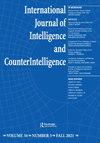Ebb and Flow of Wartime Intelligence
IF 0.5
Q4 INTERNATIONAL RELATIONS
International Journal of Intelligence and Counterintelligence
Pub Date : 2023-07-03
DOI:10.1080/08850607.2022.2032270
引用次数: 0
Abstract
Rupert Allason—most commonly known by his pen name, Nigel West—has had an impressive writing career, with more than 30 books focusing on intelligence and espionage. To be sure, West’s breadth of understanding of our British allies is uncommonly granular, and Secret War: The Story of SOE Britain’s Wartime Sabotage Organization—one of his most recent volumes—is a case in point. In Secret War, West describes a reality of wartime chaos marked by heroism, betrayal, error, and concession that was eclipsed in a postwar world more interested in a sanitized narrative of valor lest those rebuilding a devastated Europe be scandalized by their wartime compromises. The core Special Operations Executive (SOE) was sired in 1940 from the “black propaganda” organization known as Electra House and Branch “D” of the Secret Intelligence Service (Military Intelligence 6 [MI6] or SIS), responsible for sabotage. The core of 140 intelligence officers would serve under three SOE executive directors and eventually manage a cadre of 9,000 agents that would attempt to implement Winston Churchill’s admonition to “set Europe ablaze” across the whole of the British war effort from Scandinavia to Asia. In the summer of 1940, the Sitzkrieg ended, and the Wehrmacht drove through the Ardennes, thundered across France—stunning the Western allies and creating havoc as the British SIS infrastructure in France and its “Z” network dissolved as quickly as the Maginot Line. SIS Section D was then little more than an unfunded paper organization, rescued by an Americanborn British tycoon named Chester Beatty, who provided seed monies out of his personal resources to get things off the ground. Section D began coordinating with MI (R or Research),战时情报的潮起潮落
鲁珀特·阿拉森——最广为人知的是他的笔名奈杰尔·韦斯特——有着令人印象深刻的写作生涯,他写了30多本关于情报和间谍活动的书。可以肯定的是,韦斯特对我们的英国盟友的理解是非常细致的,他最近出版的一本书《秘密战争:英国战时破坏组织的故事》就是一个很好的例子。在《秘密战争》中,韦斯特描述了一个战时混乱的现实,以英雄主义、背叛、错误和让步为标志,在战后的世界里,这种混乱被掩盖了,而战后的世界更感兴趣的是一种对英勇的美化叙事,以免那些重建被摧毁的欧洲的人被他们的战时妥协所震惊。核心的特别行动执行(SOE)于1940年从秘密情报局(军情六处或SIS)的“黑色宣传”组织“伊莱克特拉之家”和“D”分支“诞生”,负责破坏活动。140名核心情报人员将在3名SOE执行董事的领导下工作,并最终管理一支9000名特工的骨干队伍,他们将试图在从斯堪的纳维亚半岛到亚洲的整个英国战争努力中,执行温斯顿•丘吉尔(Winston Churchill)“点燃欧洲”的训诫。1940年夏天,锡兹克里格战役结束,德国国防军开进阿登,轰隆隆地横扫法国,震惊了西方盟国,并造成了严重破坏,因为英国在法国的SIS基础设施及其“Z”网络像马奇诺防线一样迅速瓦解。当时,SIS D分部只不过是一个没有资金的纸面组织,由一位出生在美国的英国大亨切斯特·比蒂(Chester Beatty)拯救,他从个人资源中提供了种子资金,使事情得以起步。D部门开始与MI (R或Research)协调,
本文章由计算机程序翻译,如有差异,请以英文原文为准。
求助全文
约1分钟内获得全文
求助全文
来源期刊

International Journal of Intelligence and Counterintelligence
INTERNATIONAL RELATIONS-
CiteScore
1.00
自引率
22.20%
发文量
102
 求助内容:
求助内容: 应助结果提醒方式:
应助结果提醒方式:


